

"The mission and goal of the Golden Gringo Chronicles is to provide,
in an
informative and entertaining way, insight into
living
the
Costa Rican
experience as an expat."
1. Broken News: Firefighters 153rd Anniversary; Gran Hotel Reopens; Rebellion to the North - Nicaragua; Inflation to the South - Venezuela, Bring on the Tico Band, More Emphasis on English in Costa Rica; International Living Conference.
2. Rumble and Weather Talk: 50th Anniversary of Arenal Eruption; Rains Continue But Lessen.
3. Feature: Golden Gringo University (Pronouncing Spanish)
4. ¿Que Es Eso? Department: It's a Weasel or Maybe It's a Sick Puppy?
5. Feature: The New Malecón (The New River Walk in Quepos)
6. Health Stuff: Staying Healthy After 50.
7. GGC Bookshelf and More: Books, Golden Gringo T-Shirts and Coffee Mugs from GGC Publications as Well as Suggested Books from the Quepos-Manuel Antonio Writers Group.
8. What's-in-a-Word: 1) Answer to ¿Que Es Eso?, 2) Etymology of Bombero, 3) Etymology of Arenal
9. ROMEO Corner: Samui Thai Restaurant, Manuel Antonio
Wisdom of the Ages
Here's a grandpa keeping up with his grandkids
(must be that healthful Chinese food):
Firefighters 153rd Anniversary
In Costa Rica we don't call our firefighters by that name (we don't even call them combatientes de fuego). We call our firemen (or women) in Costa Rica bomberos (the females, of course, are bomberas), even though they don't use bombs (bombas) to put out a fire (see What's-in-a-Words section below for the interesting etymology of bombero).
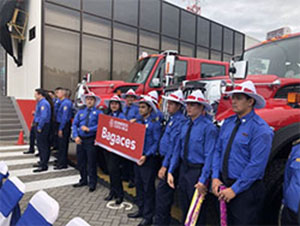 On July 27th the bomberos of Costa Rica celebrated their 153rd anniversary. I believe that puts their starting date at 1865. Wow, the country had declared its independence from Spain only 44 years before that. This year, all over the country there were celebrations of the event, including the bomberos in the town of Bagaces in Guanacaste Province.
On July 27th the bomberos of Costa Rica celebrated their 153rd anniversary. I believe that puts their starting date at 1865. Wow, the country had declared its independence from Spain only 44 years before that. This year, all over the country there were celebrations of the event, including the bomberos in the town of Bagaces in Guanacaste Province.
The Bagaces Bomberos (sounds like a good name for a rock group) were showing off their new equipment and were caught in the photo left.
But what I really liked was their hats; gotta get one.
Gran Hotel Reopens
One of the oldest and best known hotels in San José, the Gran Hotel, has been shut down for renovation for over two years. It just returned to service in July of this year under the ownership and banner of Hilton International and their Curio Collection, of which their are some 15 other Curios in Central America and a total of 50 worldwide.
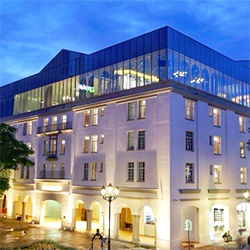 |
| The New Hilton Gran Hotel |
The hotel is located in the heart of central San José, essentially in the same block as the Plaza de la Cultura, the Teatro Nacionál and Museo de Oro. It has long served as the hotel for major international visitors including President John F. Kennedy in March 1963 who stayed there only six months before his assassination.
In the new version, the number of rooms has been reduced from 109 to 79 and all the gadgetry of a modern hotel has been added (free wi-fi, 50" TV and an "ergonomic" work area). The press report said single rooms can be had for $119 per noche but when I checked on-line bookers like Expedia and Booking.com they were quoting in the $230 range. I stayed at the charming old hotel about three years ago for $65. Such is the price of progress (and renovation). One of the most impressive rooms in the old, and I assume, new hotel is the breakfast room on the top floor that overlooks the entry facade of the Teatro Nacionál.
On a recent trip to San José I passed through the lobby of the new hotel just to see for myself what it's like. My impression is that it's sleek and modern like one would expect of a Hilton but lacks some of the classical quality of the old hotel. I wish it had mirrored the beauty of the Teatro across the street but I'm sure duplicating rococo these days is more than likely financially prohibitive. Yet the Gran Hotel, as a quality property and given it's location, is certain to do well.
Rebellion to the North - Nicaragua
The violence may have abated somewhat but sporadic shootings by the government's paramilitary forces continue in some parts of the country. The death toll from these transgressions exceeded 350 since the demonstrations started in April. Last month the U.S. government joined the international chorus (reported by A.M. Costa Rica):
"Free, fair, and transparent elections are the only avenue toward restoring democracy in Nicaragua. We support the Catholic Church-led national dialogue process for good faith negotiations. The Trump Administration has designated (and sanctioned - Ed.) three Nicaraguan officials – Francisco Diaz, Fidel Moreno, and Francisco Lopez – under the Global Magnitsky Act for human rights abuses and corruption.
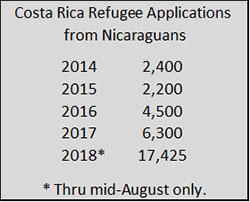 In the meantime the Migration Department in Costa Rica was being overwhelmed with new applications for refugee status (table left). The last couple of years have seen a trend upward in the number of Nicaraguans applying for refugee status but, since the violence started in April, the number has skyrocketed.
In the meantime the Migration Department in Costa Rica was being overwhelmed with new applications for refugee status (table left). The last couple of years have seen a trend upward in the number of Nicaraguans applying for refugee status but, since the violence started in April, the number has skyrocketed.
The government has dug in and has a powerful military behind them. Let's hope a solution can be found to this situation before we have another Venezuela on our hands.
Inflation to the South - Venezuela
 |
| The New Bolivar |
Meanwhile, the turmoil was of a different kind, at least at the moment, with the continuing fiscal and financial crisis in Venezuela. With the inflation rate expected to reach 1,000,000% (no, that's not a mistake, it's the rate forecast by the International Monetary Fund) during 2018, the government was busy trying to revalue its currency. It is issuing a new currency, the “sovereign bolivar” which will be traded versus the old bolivar at the rate of 100,000 to 1.
Nifty eh? Just drop 5 zeros from the old bills and le voila, you've got a new one. The value of a currency is, of course, not what you write on the paper bills, it's the strength of the underlying economy and this regime has spent money like a spendthrift who just won the Powerball (the policies are known as el chavismo or the policy of Hugo Chaves).
With the country having the largest oil reserves in the world (much of it confiscated from foreign oil companies) what could go wrong? Oh, just the economy collapsing. With the currency change has come hoarding of food and many other common household items.
The Venezuela problem is similar to the Nicaraguan trouble in one important aspect - unfettered migracion. The dramatic increase in Nicaraguan refugee applications in Costa Rica and continuing immigration into Costa Rica was noted above. In Venezuela large numbers of people are crossing over the borders north (Colombia), south (Bolivia, Brazil) and west (Peru, Ecuador). Some will go back because they were only shopping for things that they can't get in Venezuela, like food, but many won't return.
Bring on the Tico Band
On a lighter side, an announcement was made that the Marching band from San José known as the Acosta band will participate in the 2019 Rose Bowl Parade in Pasadena, California. President Carlos Alvarado said this about the band: “You represent the best of our country, our culture, our tradition of peace, our talent and the values that we must stand for, protect and cultivate at all costs”.
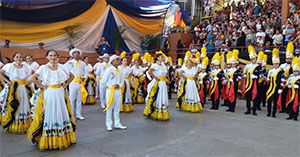 |
| Banda Acosta de San José |
It must be noted that the Acosta Band will also be the only band from Latin America participating in the parade. Go Ticos!
To see El Banda Acosta in an action video, go here: https://youtu.be/Fx40zcLxq5M.
To hear another version of the background theme used in the video and explore the Tico culture a little more, go here (article written in 2012): Soy Tico
More Emphasis on English
A new national project was recently initiated by the President of Costa Rica himself. Señor Alvarado put it this way: "The challenge is to forge a true alliance to extend the teaching of English and other languages as a state policy that ensures universal access opportunities for people of all ages and from all territories."
The program is ambitious and includes six initiatives:
 |
| Whoa, I'd Sign Up for That Class! |
1. Approval of an additional ¢5 billion ($885,000) for Empléate, a job program of the Labor Ministry, which will be used for bilingual training for the unemployed.
2. Universalize the teaching of English in preschool to cover approximately 125,000 students.
3. Application of a diagnosis this year of English language proficiency for 10,000 students from all over the country.
4. Implementation of English language certification tests, starting in the 2019 to 2022 period, reaching approximately 180,000 students in 2022.
5. Certification of English language levels with international standardized tests to all students of programs in English of the National Institute of Learning.
6. Application, as of October, of diagnostic tests and certification with international standards for the 223 teachers of the English language of the National Institute of Learning, accompanied by a training plan that allows raising the quality and relevance of teaching.
Buen trabajo amigos (and I'll keep practicing my Español too).
International Living Conference
 GG had the opportunity to attend the International Living Magazine Fast Track Costa Rica Conference held at the Real Intercontinental hotel in Escazu this past August 16-18. I was asked to represent the Central Pacific Coast because some good friends, who had done it before but who have since returned to the U.S., put my name in as a replacement (thanks Mary and Lance). The conference was attended by almost 350 would-be expats or people who have just moved here.
GG had the opportunity to attend the International Living Magazine Fast Track Costa Rica Conference held at the Real Intercontinental hotel in Escazu this past August 16-18. I was asked to represent the Central Pacific Coast because some good friends, who had done it before but who have since returned to the U.S., put my name in as a replacement (thanks Mary and Lance). The conference was attended by almost 350 would-be expats or people who have just moved here.
I recently finished my twelfth article for International Living in the last couple of years, primarily short articles on living here (IL calls them "Postcards") or profiles of people who have successfully made the transition to resident and expat status.
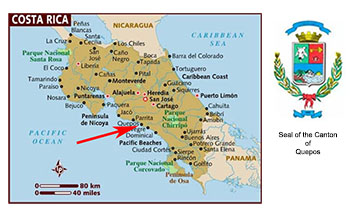 |
| Slide from GG's Presentation |
IL offers these conferences to people either trying to decide if Costa Rica is a good place for them to move as an expat or have made the decision and are looking to learn how to make the move efficiently. Three days of presentations ensued with ample opportunity to interact with other presenters who are primarily resident expats like GG with years of experience living in Costa Rica. Coffee breaks, lunches and dinners also provided an ample opportunity for interaction between the attendees and the presenters.
GG made his PowerPoint presentation on the morning of the last day talking about why I chose Costa Rica and, more particularly the Quepos-Manuel Antonio area.
I met lots of good people from North America and more good people from other parts of the world. It was a great way to break the ice and welcome new friends.
¡Pura Vida!
50th Anniversary of Arenal Eruption
GG reported on his adventure traveling with a friend and discovering Volcan Arenal in May. I called it a volcano with a personality then and indeed it is, but sometimes a volcano's personality can turn angry.
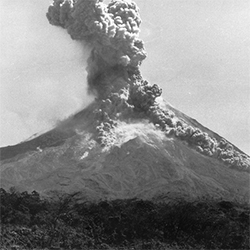 |
| Arenal Exploding in 1968 |
July 29th this year was an ominous day for those who lived near Arenal exactly 50 years prior. On that date in 1968 the volcano had a major eruption accompanied by a "hoarse growl" that shook the villages nearby and greatly darkened the sky (see photo left). Until that day local inhabitants had considered Arenal dormant because of no "verified historical records" that it had ever exploded.
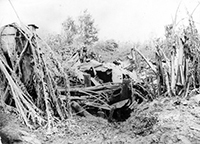 |
| A Farm Near Arenal After The 1968 Explosion |
The worse part of the 1968 eruption was that it "devastated an area of 15 square kilometers in three days, killed 78 people and caused great losses in crops and livestock for 230 square kilometers around the mountain". The volcano is located about 90 kilometers/55 miles northwest of San Jose near the town of La Fortuna. The funnel is about 1,700 meters or 5,500 feet high. The volcano has been quiet since 2010 when it had an "avalanche" flow of lava but which was not as powerful or damaging as the 1968 disaster.
When you live on the rim amigos, it's only a matter of time until something happens.
Venezuela Suffers a 7.3 Tremor
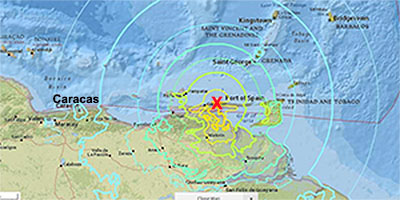 As if all the political and financial upheaval mentioned above wasn't enough, Venezuela suffered a 7.3 earthquake on Tuesday, August 21, 2018 within 200 miles of the capital city of Caracas. It was strongly felt in Caracas and several injuries were reported there, some from the collapse of an escalator. Yet, fortunately, there appears to have been no fatalities.
As if all the political and financial upheaval mentioned above wasn't enough, Venezuela suffered a 7.3 earthquake on Tuesday, August 21, 2018 within 200 miles of the capital city of Caracas. It was strongly felt in Caracas and several injuries were reported there, some from the collapse of an escalator. Yet, fortunately, there appears to have been no fatalities.
There have been eight major quakes (+6.5) in this region in the last one hundred years with this one exceeded only by a 7.7 in 1900 which occurred essentially within the capital zone.
The latest quake was felt as far away as Bogota, Columbia, some 1,000 kilometers or 600 miles from Caracas.
Check Out Recent Earthquakes Around the World Posted by the U.S. Geodetic Survey: Recent Quakes |
Rains Continue But Lessen
 The heavy tropical rains we've been getting this season, particularly in the Caribbean zone (often called the Atlantic Zone), lessened enough in late July and early August to allow some recovery. Slowly the 200 plus schools that were closed during the worst of the flooding reopened, electricity was restored in the Turrialba and Limón areas and dozens of landslides were cleared away to reopen both major and secondary routes. Repairing the damage to individual homes will take many months.
The heavy tropical rains we've been getting this season, particularly in the Caribbean zone (often called the Atlantic Zone), lessened enough in late July and early August to allow some recovery. Slowly the 200 plus schools that were closed during the worst of the flooding reopened, electricity was restored in the Turrialba and Limón areas and dozens of landslides were cleared away to reopen both major and secondary routes. Repairing the damage to individual homes will take many months.
Another press report stated that the Limón area had experienced 71% more rain in July than the historical average. We're not out of the woods yet as there are still a number of rivers that are high enough to present a potential threat to overflowing should we get more major storms.
The large rain storms that come in from the Caribbean here are often referred to as Tropical Waves. As of August 1, the Tropical Wave count had reached 22 for this year already and there are four more months to go in the rainy season including October and November which hold the historical records for the rainiest months. In mid-August yet another wave was forecast prompting a yellow alert in the Limón area.
Stay dry and be careful amigos.
Search the Golden Gringo Chronicles Archives for Topics That Interest You
You can use our Archives to search for anything that has been written in more than 220 feature articles of the Golden Gringo Chronicles plus find Broken News items and ROMEO restaurant reviews. Enter your topic or item to search in the Google Search Routine below and follow the links offered from the search results. Suggestion: Enter only a simple, precise and unique as possible keyword or two in order to narrow the number of references retrieved:
Readers: Our publication is open to suggestions regarding future articles and will accept pieces written by others but we reserve the right to decline anything that the editorial staff (that's GG) thinks is inappropriate for this format. Send proposals, comments, suggestions, ideas, meaningless statements and jocular observations concerning the Chronicles to GG here: gg@goldengringo.com.
 The idea behind Golden Gringo University is to present educational topics of wide interest to expats who have recently moved to Costa Rica, or to future expats who might be thinking of moving here, or to those who simply visit here frequently.
The idea behind Golden Gringo University is to present educational topics of wide interest to expats who have recently moved to Costa Rica, or to future expats who might be thinking of moving here, or to those who simply visit here frequently.
Our goal and objective at GGU is to provide accurate information that readers will find helpful in their efforts to be a good expat resident/visitor in Costa Rica.
For additional topics that have been covered under the GGU theme go here: GGU Archive. In this issue we discuss the importance of learning to pronounce Spanish properly. GG ventures at risk into the wonderland of linguistics with this article but damn the torpedoes, full steam ahead.
I do not pretend to be a linguist or even a person of solid capability or fluency in Spanish but I pledge to keep on trying to get there. I found it a bit more difficult than I had hoped to grasp a new language, partly because I began doing it at the age 65 (at least that's my excuse). I overestimated the ability of the aged cranium to absorb, retain and extract even simple words. The worst of it all is the limited ability of extracting words at will, or at least in time to use them in a conversation, a process that can be excruciatingly slow and emotionally irritating. And that problem is not just about Spanish; hell, I'm having problems extracting English words these days even though I know (or have known) them well in the past.
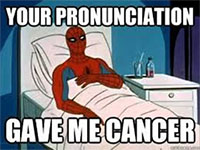 An on-line Spanish teaching system recently sent me an electronic notice that started out with this quote: "It's not so important for you to pronounce the word correctly as it is to know the right word".
An on-line Spanish teaching system recently sent me an electronic notice that started out with this quote: "It's not so important for you to pronounce the word correctly as it is to know the right word".
Horse hockey and hog waller says GG!
You can use a perfectly good word but pronounce it badly and you might as well be speaking a different word or speaking in a different language. Not all the kind and expatriate-tolerant Ticos will recognize a pronunciation error and be able to compensate for it. Methinks you must know both the word and how to pronounce it, or at least try to. So one goal becomes getting used to the differences in pronunciation.
El Alphabeto
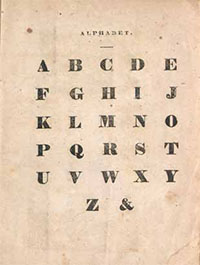 Let's start with the alphabet. The English alphabet is memorized by young students in the first few years of school. The system includes a total of 26 letters, although the collection of letters in earlier centuries also often included the ampersand - &, but I'm not sure why or how it was used. The English alphabet on the other hand is blessed with relative simple pronunciations (which may be why it has always been the preferred language for business: A (ay), B (be), C (see),...Z (zee). The pronunciation of letters is long and broad and pretty simple.
Let's start with the alphabet. The English alphabet is memorized by young students in the first few years of school. The system includes a total of 26 letters, although the collection of letters in earlier centuries also often included the ampersand - &, but I'm not sure why or how it was used. The English alphabet on the other hand is blessed with relative simple pronunciations (which may be why it has always been the preferred language for business: A (ay), B (be), C (see),...Z (zee). The pronunciation of letters is long and broad and pretty simple.
The chart at left is a reproduction of the standard English alphabet used in the U.S. as it was printed in the late 19th century; it hasn't changed much at all since then except for the apparent disregard of "&". Just for fun also note that two of the English letters are also complete words by themselves (i.e., "A" and "I"). Simplicity at it's simplest.
 |
| The 30 Letters of the Spanish Alphabet |
The Spanish alphabet right, El Alphabeto, is a bit more complicated. It consists of some 30 letters including four "kind-of-double" letters (c/ch, l/ll, n/ñ and r/rr). Ch, ll, ñ and rr make up the four extra letters compared to English. In the table to the right all the letters are accompanied below them by their common pronunciation Note that, unlike English, there are no letters in Spanish that are words by themselves (although "a" is an article).
Note that the pronunciation is nothing like their English equivalents; in most cases the Spanish pronunciation is gentler than the English counterpart (ah vs A, deh vs D, peh vs P). Some others have a pronunciation totally different from the English equivalent; these include heh for G, ach-eh for H and peh for P (the English sound for the "eh" parts in all of these is "ay"). My favorite Spanish letter sounds are hota for j, dob-leh-uuh (like double u) for w and ee-gri-ch-gah for y. Are we having fun yet? There's lots more.
And oh yes, I am cautioned by my more learned friends that the classic alfabeto above, much like the way the "&" fell into disuse in English, has been reduced for the benefit of we moderns to 27 letters; the ch, ll and rr mentioned above are now treated and considered like English. Their pronunciations in Spanish, of course, are still different. (illegal in English is like il-lee-gull but might sound more like eel-leh-gal in Spanish).
The most fun can be had dealing with the double l and the v and b. Take calle (street) for example. The standard pronunciation is ki-yeh but I've also heard it as ki-jay with a hard j. Sometimes it seems that when a certain emphasis is desired ll is replaced with a j. On the other hand when you have developed a certain capability to pronounce v and b, at the same time, you can be said to have made progress. Valentina (the name of my landlady's new granddaughter) comes out balentina (soften the b and try to slip in a little v and you'll start to sound like a Tico, hopefully).
Vowel Arousal

Note that all the vowels in El Alphabeto above have a softer pronunciation that their English counterparts. It's no longer A-E-I-O-U but Ah-Ay-Ee-Oh-Ooh, the Spanish pronunciation being much softer. The other way of thinking of Spanish vowels is that they are similar to English short vowels. It takes practice and a certain acceptance of responsibility on the part of the student to use the different pronunciation correctly. You can easily see how using the long form of English pronunciation for a vowel comes across to a Spanish speaker as a different vowel, to wit: the sound of E in English could be an "I" in Spanish and vice-versa.
Consonants don't suffer from that mixing problem but it doesn't take long to realize that Spanish rarely, if ever, uses double consonants while English often favors them. Here are just a few of many examples (English first, followed by the Spanish version in parentheses): difficult (difícil), aggressive (agresivo), necessary (necesario), apparatus (el aparato) and traffic (el tráfico). I like the Spanish version much better - it's simpler and offers less chance for misspelling.
The Magic Tilde
In this writer's opinion Spanish seems more complicated that English but has one advantage over English in that it offers, in many cases, an added guide to proper pronunciation; it's called a tilde and is an accent mark placed over a letter in the syllable (sílaba) that is to receive emphasis. You may have noticed the tildes in the paragraph above on the second "i" in difícil and the "a" in tráfico (it's also over the "i" in sílaba in the previous sentence).
 The tilde helps distinguish the pronunciation from one of the more common rules in pronouncing Spanish: "without the tilde the emphasis on pronunciation of a word normally comes on the penultimate syllable (i.e., the second to last syllable of the word).
The tilde helps distinguish the pronunciation from one of the more common rules in pronouncing Spanish: "without the tilde the emphasis on pronunciation of a word normally comes on the penultimate syllable (i.e., the second to last syllable of the word).
This of course only works easily for the written word and even there many local people, I have observed, tend to forget the little mark in their writing or on signs and, in that case, you still have to know the correct pronunciation by memory.
The slash mark tilde also has a sister tilde, the one used over the nnn-yeh (ñ) in requiring the emphasis be placed on the syllyable in which the ñ is found (like in señor).
Some Other Thoughts
Some teachers point out that usually the same thought or sentence can be expressed in Spanish with fewer words. Acepto! (I accept; acepto saved the word "I"). OK, but why then are there more than 50% more sílabas (syllables) in many typical Spanish phrases for the same supposedly shorter sentences?
As a minor example, take the power company here, ICE (in the beginning I thought the trucks with "ICE" on the side were the immigration department). ICE = Instituto Costarricense de Electricidad. I count 15 syllables in the expanded acronym. Compare this to FPL, Florida Power and Light at 7 syllables. Spanish spoken fast can be rather machine-gun like making it that much more difficult for an old dude like me to distinguish individual sounds and words.
And then there's the way you say things. For months I would stop at a little stand near the bus station for a couple of quite tasty empanadas and a Tampico citrus drink for breakfast. They usually have two or three varieties of these deep-fried turnovers, stuffed with cheese or pinto con carne and I would say "Una de Cada, por favor". The clerk would either put one in a baggie and hand it to me or ask which one? I couldn't understand why she didn't understand that I was saying "One of each".
Finally one day there was a Tica woman standing next to me and I asked if Una de Cada was proper and she said "Una de Cada Una" was the right answer for one of each. It's grammatically correct in English also (one of each one) but most gringos would consider the second "one" superfluous. Not my Tico buddies.
 OK, that's enough (basta!) of this pronunciation stuff for now. By the way it also takes about five times the usual time to run spell checker on something like this.
OK, that's enough (basta!) of this pronunciation stuff for now. By the way it also takes about five times the usual time to run spell checker on something like this.
Maybe in the future if I get brave enough we can talk about diphthongs and verbs (Dios nos bendiga, amigos! - God help us!). In the meantime I await the onrush of reader comments that will straighten out my abuse of Spanish.
¡Solo Bueno!

A sick puppy (with snout disorder)?
Perhaps it's a Weasel.
Answer in What's-in-a-Word section below.
¡Pura Vida!
This month on September 21 GG achieves a personal landmark of having lived in Costa Rica for ten years. During that time I have seen the country, and particularly Quepos, grow substantially. Here are some statistics:
 |
| Population of Costa Rica |
During the last ten years alone the population of Costa Rica increased by about 13% or more than 500,000 and is now estimated to be around 5,000,000. For perspective, recall that the population of Costa Rica in 1948 at the founding of the Second Republic was 726,000 (a 580% increase to now) and in 1960 the population was 1,333,000 (a 270% increase from then until today).
I have also seen a substantial development in infrastructure (roads, utilities, telecom). When I first visited here in 2003 there were 13 one-lane bridges between Quepos and the International Airport in San Jose (there were three in Quepos alone). Now, with the opening of the Autopista a few years ago and reconstruction of many bridges into two or more laners, there are none.
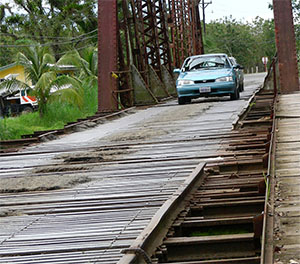 |
| The Bridge at Parrita - Cerca 2005 |
One of my favorite bridges, until it was finally replaced with a two-lane modern structure, was the bridge at Parrita, a town about fifteen miles up the coast from Quepos. The cement under-flooring to this span had been dissipated considerably by the time GG came on the scene and I used to think it fun to be able to look through the slats and the rebar under them to see the river rapidly moving below.
Later I learned to hold back and give the Mack truck filled with stones a little more leeway when it was crossing in front of me and making the bridge sway. Of course, one was anxious to get across because you had to wait up to 30 minutes for the traffic in one direction to whittle down so the traffic in the opposite direction could begin its turn; there were no traffic lights.
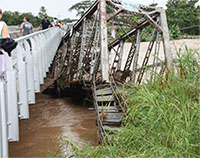 In the floods of 2010, the old bridge was washed off it's supports and smashed into the new bridge (photo right). The old bridge was then cut into pieces with torches and removed piece by piece. Fortunately the strong new bridge wasn't seriously damaged (I guess that's so, because I never saw any repairs being done).
In the floods of 2010, the old bridge was washed off it's supports and smashed into the new bridge (photo right). The old bridge was then cut into pieces with torches and removed piece by piece. Fortunately the strong new bridge wasn't seriously damaged (I guess that's so, because I never saw any repairs being done).
Another area that has shown tremendous improvement since I've been here is the Malecón (pronounced mal-eh-kone). This is the dyke or breakwater that protects the city form the Pacific and moderate sized tsunamis (yuk, yuk) located at the river and bay area downtown. GG first wrote an article about this area of Quepos, (Malecon) in 2015 when serious changes were underway to beautify the area. At that time I noticed that, all of a sudden, the overgrown shrubbery was being landscaped, the top of the dam was paved and artful statuary began to appear.
Since then there has been a steady improvement in the look and usefulness of the place. Substantial lighting has been added that makes the walk along the Malecón a much more attractive possibility at night. Recently a large numbers of benches have been added separated by large planters containing trees and flowering shrubs.
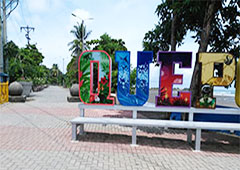 |
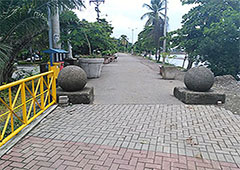 |
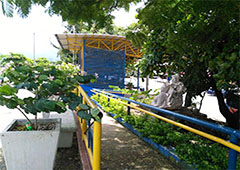 |
| North Entrance to Malecón | Spheres at Entrance | New Band Shell |
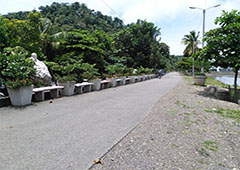 |
 |
 |
| Mid-Malecón Showing Benches | ShowingSouth-End Shade Park | Skateboard Park (South End) |
 |
||
| Sunset View From the Malecón (I Expect the New Benches Will Be Busy) | ||
I haven't measured the full length of the Malecón but I'm guessing it's approaching a kilometer (six-tenths of a mile) from the north entrance to the marina where it terminates. The north entrance has a new, lighted and colorful Quepos sign and also two of the mysterious stone spheres that were found in southern Costa Rica. I haven't decided whether these particular ones are the real McCoy or simply cement reproductions but they look real and they're not easy to replicate in cement.
The middle part of the walk has the bulk of benches that look toward the river, the marina, the bay and straight ahead to those incredible Pacific sunsets for which Costa Rica's coast is famous. The south end of the park is still under construction but it will include a very pleasant and shaded park as a rest area. Also recently constructed at the south end is a new skateboard park that quickly became popular with the younger set who expectedly assumed their proper positions to bump and scrape over the inclines.
The "new" Malecón is indeed a river walk of which the city and it's inhabitants can be proud.
¡Solo Bueno!
| Note: The information given in this section is offered as news information only and does not indicate GGC confirmation or denial of the accuracy of the treatment or a recommendation to pursue it, nor can we or do we guarantee the efficacy of the results nor validity of the conclusions proffered. (How's that for a disclaimer?) |
The executive president of Social Security Administration in Costa Rica (CCSS or the Caja), Señor Román Macaya Hayes, recently commented on the state of the elderly which he unkindly said were those over 50. He stated that only about 20% over the age of 64 are truly healthy, that is not having diabetes, hypertension, high cholesterol and with no current smoking or alcohol consumption. GG is good on 4 out of five of these, having Type II Diabetes.
 Inactivity and bad diet are the culprits says Señor Macaya. Couldn't agree more but there are limits, like not taking on mountain trails at the age of 74 as GG discovered. Also from Señor: "...eight out of 10 have diseases that are related to habits that are the responsibility of the patient, such as a diet high in fats, sugars, and flour and a sedentary lifestyle".
Inactivity and bad diet are the culprits says Señor Macaya. Couldn't agree more but there are limits, like not taking on mountain trails at the age of 74 as GG discovered. Also from Señor: "...eight out of 10 have diseases that are related to habits that are the responsibility of the patient, such as a diet high in fats, sugars, and flour and a sedentary lifestyle".
So it's back to the problem of avoiding excessive carbs unlike the dude on the right (which isn't me by the way)".
¡Pura Vida!

 GGC Publications Group is the parent organization that publishes the Golden Gringo Chronicles as well as a number of books and paraphernalia related to the Chronicles and Costa Rica. The GGC Bookshelf also includes works from a number of other authors that belong to the Quepos-Manuel Antonio Writers Group in which GGC has been a founding member.
GGC Publications Group is the parent organization that publishes the Golden Gringo Chronicles as well as a number of books and paraphernalia related to the Chronicles and Costa Rica. The GGC Bookshelf also includes works from a number of other authors that belong to the Quepos-Manuel Antonio Writers Group in which GGC has been a founding member.
Here are the books currently on our bookshelf:
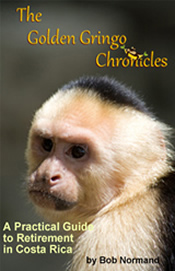 |
 |
 |
 |
| The Chronicles as a Narrative | Mariposa - English | Mariposa - Español | Small Business Guide |
| Read More | Read More | Leer más aquí | Read More |
 |
 |
 |
 |
| Overcoming Drinking | Making Time Count | Spiritual Love Connection | Murder or Suicide? |
| Read More | Read More | Read More | Read More |
 |
There's Room for More on the QMA Writers Group Bookshelf | There's Room for More on the QMA Writers Group Bookshelf | There's Room for More on the QMA Writers Group Bookshelf |
| Getting Around the Capital | TBA | TBA | TBA |
| Read More |
All of the above books are available on Amazon.com and the "Read More" links above will lead you to them. You can also find them all on our GGC Publications Page.
GGC Publications also offers some accessories and paraphernalia related to the Chronicles and with Costa Rican themes, to wit;
 T-Shirts:
T-Shirts:
a. Golden Gringo Chronicles with Logo,
b. Official Golden Gringo with Monkey on Banana Hammock,
c. ¡Quepo en Quepos! ("I Fit In Quepos!") with Photo of Quepos,
d. Wanna Monkey Around? - Come on Down! with Photo of White Face Monkey,
e. It's OK to be Slothful with photo of Three-Toed Sloth.
The t-shirts are available in several colors, styles and sizes. See them HERE.
Coffee Mugs: a. Golden Gringo, b. Wanna Monkey Around?, c. OK to be Slothful
What's life without a great cup of Costa Rican coffee? And it tastes even better in a Golden Gringo Chronicles mug!
Answer to Que Es Eso?
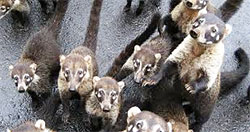 It's not a weasel but a cute little dude called a Coatimundi or "coati" for short. A member of the raccoon family they are prevalent in many areas of Costa Rica. The snout and long tail give them away. They actually lean back on those tails for support and look like prairie dogs except they're bigger, are colored differently and sport those long snouts.
It's not a weasel but a cute little dude called a Coatimundi or "coati" for short. A member of the raccoon family they are prevalent in many areas of Costa Rica. The snout and long tail give them away. They actually lean back on those tails for support and look like prairie dogs except they're bigger, are colored differently and sport those long snouts.
 Coatis often travel in packs or troops like that shown above, left. GG isn't sure why they have a nearly constant sad look on their faces unlike their forest buddies the sloths who have been affixed with a permanent smile, like the hairy dude to the right.
Coatis often travel in packs or troops like that shown above, left. GG isn't sure why they have a nearly constant sad look on their faces unlike their forest buddies the sloths who have been affixed with a permanent smile, like the hairy dude to the right.
Bomberos
So "bomba" can be a bomb or a pump (don't ya just love it when Spanish gets so flexible?)
I figured out this little bit: “bomba” seems to be from the Latin “bombus” and Greek “bombos” which is for anything from a deep sound to a buzzing noise. In Italian, bombo is bumblebee (now there's a buzzword).
So Spanish “bomba” = pump or bomb, and presumably a bombero/firefighter would be pumping water rather than lobbing grenades. The evolution of bomba from meaning “noise” to meaning “explosive” makes sense. The big question is, how did “bomba” come to mean “pump”? Were Spanish pumps named for the noise they generated? Or does it come from an entirely different word?
Just don't throw any bombs amigos.
Arenal
Literally translated arenal means sandy area or quicksand, neither of which I saw near the volcano or on the trail we slogged through. But then perhaps I didn't look close enough. I'm told that there are other names for this famous peak: “Pan de Azúcar”, “Canaste“, “Volcan Costa Rica”, “Volcan Río Frío” or “Guatusos Peak”.
Samui Thai Restaurant, Manuel Antonio
Location: Top of Manuel Antonio hill on the corner across the street from the Promerica Plaza (this is the old location for the Falafel restaurant).
Hours: Lunch and Dinner (11:30 AM to 9:30 PM)
Parking: None provided at the restaurant; street or plaza parking only.
Contact: Tel.: 2777-1292; Email: N/A; Website: N/A
Reviewing ROMEOS: Anita M., Bob N., Glen N., Lorenzo, Maggie J.
To Review Our Rating System and Procedure, go here: R.O.M.E.O. Rating System
This is a new restaurant offering Thai food by way of the name Samui. It has taken up residence at the old Falafel restaurant location, the latter moving up the street about a half mile. The interior is mostly a deck that overlooks the hill that plunges down to the Pacific. The sunset view is hampered somewhat by an enormous tree in the middle of the diner's view of the sea and horizon. The tables and benches give the place an outdoor feeling. The composite score for ambiance from the group came in at 4.0/5.0 sloths.
(Photos shown below were taken by the official ROMEO club photographer - Anita M.)
Other ROMEOs chose 1) a wok basil chicken (with little basil), a fried tofu ("small but tasty") and a Laap Salad ("small"). |
 |
|---|---|
| $$$$.2 | |
Value Index= 85 |
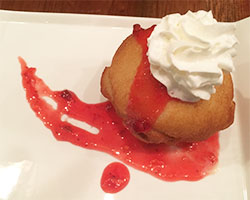 Three of us had fried ice cream for dessert which I thought delicious (photo right). Others, more experienced with Asian food than I reported it to be average. Our composite score for food quality was 2.8/5.0 sloths.
Three of us had fried ice cream for dessert which I thought delicious (photo right). Others, more experienced with Asian food than I reported it to be average. Our composite score for food quality was 2.8/5.0 sloths.
Service by two different young ladies was friendly and attentive receiving a composite score of 3.9 and yielding an average score for ambiance, food quality and service of 3.6 sloths.
The cost for my Thai Pad, fried ice cream and a diet coke came to be 17,400 colones (about $31). For that I gave the Samui a 4.0/5.0 for cost; the composite score was 4.2 making the Value Index 3.6/4.2x100=85 and putting Samui in the lower 1/3 for value on the list that we've evaluated in the past three years.
At this stage in its development Samui is basic in its offering fully priced. GG would be interested in knowing from our readers if they have a different experience.
¡Pura Vida!
The Golden Gringo Chronicles is a free newsletter that is non-political, non-commercial and, hopefully, entertaining. By signing up you will receive an email each month around the first of the month giving you the links to the latest edition as well as to each individual feature and departmental section.
CLICK HERE TO SIGN-UP FOR THE GOLDEN GRINGO CHRONICLE
or Email me at gg@goldengringo.com, or use our Website at: www.goldengringo.com

Bob Normand, Editor
& The Golden Gringo
Pura Vida!
To Contact GGC World Headquarters (yuk, yuk) to make comments, suggest topics or criticize my bad jokes, just send an email to: gg@goldengringo.com.
Be pithy but kind; I'm sensitive.
Unsubscribe from Golden Gringo Chronicles